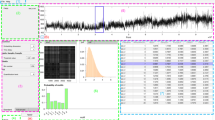Abstract
An attempt was made to develop a truly quantitative approach to temperature, based on models derived from nonlinear dynamics and chaos theory. Three different procedures for measuring the degree of complexity of the temperature curve were compared, and the possible correlations between these measurements and certain physiopathologically relevant parameters in healthy subjects were examined. Twenty-three healthy subjects (10 males, 13 females) between 18 and 85 years of age had their temperature measured every 10 min for at least 30 h. These time series were used to determine the approximate entropy (ApEn), a detrended fluctuation analysis (DFA), and the fractal dimension by the compass method (FDc). There was good correlation between the different methods of measuring the complexity of the curve [r=−0.603 for ApEn vs. DFA (p=0.002), r=0.438 for ApEn vs. FDc (p=0.04) and r=−0.647 for DFA vs. FDc (p=0.0008)]. Both the fractal dimension and the approximate entropy were inversely correlated with age [r=−0.637 (p=0.001) and r=−0.417 (p=0.03), respectively], while the DFA increased with age (r=0.413, p=0.04). The results thus suggest that complexity of the temperature curve decreases with age. The complexity of the temperature curve can be quantified in a consistent fashion. Age is associated with lower complexity of the temperature curve.







Similar content being viewed by others
References
Cross SS, Cotton DWK (1994) Chaos and antichaos in pathology. Hum Pathol 25:630–637
Bigger JT, Steinman RC, Rolnitzky LM, Fleiss JL, Albrecht P, Cohen R (1996) Power law behavior of RR-interval variability in healthy middle-aged persons, patients with recent acute myocardial infarction and patients with heart transplants. Circulation 93:2142–2151
Gisiger T (2001) Scale invariance in biology: coincidence or footprint of a universal mechanism? Biol Rev 76:161–209
Goldberger AL (1992) Fractal mechanisms in the electrophysiology of the heart. IEEE Eng Med Biol 11:47–52
Goldberger AL (1996) Non-linear dynamics for clinicians: chaos theory, fractals and complexity at the bedside. Lancet 347:1312–1314
Goldberger AL (1999) Nonlinear dynamics, fractals and chaos theory: implications for neuroantonomic heart rate control in health and disease. In: Bolis CL, Licinio J (eds) The autonomic nervous system. World Health Organization, Geneva
Goldberger AL, West BJ (1987) Fractals in physiology and medicine. Yale J Biol Med 60:421–435
Goldberger AL, Rigney DR, West BJ (1990) Chaos and fractals in human physiology. Sci Am 262:42–49
Hausdorff JM, Purdon PL, Peng CK, Ladin Z, Wei JY, Goldberger AL (1996) Fractal dynamics of human gait: stability of long-range correlations in stride interval fluctuations. J Appl Physiol 80:1448–1457
Hausdorff JM, Mitchell SL, Firtion R, Peng CK, Cudkowicz ME, Wei JY, Goldberger AL (1997) Altered fractal dynamics of gait: reduced stride-interval correlations with aging and Huntington's disease. J Appl Physiol 82(1):262–269
Havlin S, Buldyrev SV, Goldberger AL, Mantegna RN, Ossadnik SM, Peng CK, Simons M, Stanley HE (1995) Fractals in biology and medicine. Chaos Solutions Fractals 6:171–201
Huikuri HV, Mäkikallio TH, Airaksinen J, Seppänen T, Puuka P, Räihä IJ, Sourander LB (1998) Power-law relationship of heart rate variability as a predictor of mortality in the elderly. Circulation 97:2031–2036
Iyengar N, Peng CK, Morin R, Goldberger AL, Lipsitz A (1996) Age related alterations in fractal scaling of cardiac interbeat interval dynamics. Am J Physiol 271:R1078–R1084
Lancet (editorial) (1991) Fractals and medicine. Lancet 338:1425–1426
Lipsitz LA, Goldberger AL (1992) Loss of "complexity" and aging. Potential applications of fractals and chaos theory to senescence. J Am Med Assoc 267:1806–1809
Mackowiak PA, Wasserman SS, Levine MM (1992) A critical appraisal of 98.6ºF, the upper limit of the normal body temperature, and other legacies of Carl Reinhold August Wunderlich. J Am Med Assoc 268:1578–1580
Mäkikallio TH, Huikuri HV, Hintze U, Videbaek J, Mitrani R, Castellanos A, Myerburg R, Moller M (2001) Fractal analysis and time- and frequency-domain measures of heart rate variability as predictors of mortality in patients with heart failure. Am J Cardiol 87:178–182
Mandelbrot B (1967) How long is the coast of Britain? Statistical self-similarity and fractional dimension. Science 156:636–638
Moody GB, Peng CK, Stanley Goldberger AL, Amaral LAN, Glass L, Hausdorff JM, Ivanov PC, Mark RG, Mietus JE (2000) PhysioBank, PhysioToolkit, and Physionet: components of a new research resource for complex physiologic signals. Circulation 101(23):e215–e220 [http://circ.ahajournals.org/cgi/content/full/101/23/e215]
Peitgen HO, Jürgens H, Saupe D (1992) Fractals for the classroom. Springer, Berlin Heidelberg New York, pp 218–232
Peng CK, Havlin S, Hausdorff JM, Mietus JE, Stanley HE, Goldberger AL (1995a) Fractal mechanisms and heart rate dynamics. Long-range correlations and their breakdown with disease. J Electrocardiol 28: [Suppl.] 59–65
Peng CK, Havlin S, Stanely HE, Goldberger AL (1995b) Quantification of scaling exponents and crossover phenomena in nonstationary heartbeat series. Chaos 5 (1):82–87
Peng CK, Hausdorff JM, Goldberger AL (2000) Fractal mechanisms in neural control: human heartbeat and gait dynamics in health and disease. In: Walleczek J (ed) Self-organized biological dynamics and nonlinear control. Cambridge University Press, Cambridge, UK
Pikkujämsä SM, Mäkikallio TH, Sourander LB, Räihä IJ, Puuka P, Skyttä J, Peng CK, Goldberger AL, Huikuri HV (1999) Cardiac interbeat interval dynamics from childhood to senescence. Comparison of conventional and new measures based on fractals and chaos theory. Circulation 100:393–399
Pincus SM (1991) Approximate entropy as a measure of system complexity. Proc Natl Acad Sci USA 88:2297–2301
Pincus SM, Goldberger AL (1994) Physiological time-series analysis: what does regularity quantify? Am J Physiol 266:H1643–H1656
Pincus SM, Gladstone IM, Ehrenkranz RA (1991) A regularity statistic for medical data analysis. J Clin Monit 7:335–345
Vikman S, Mäkikallio TH, Yli-Mäyry S, Pikkujämsä S, Koivisto AM, Reinikainen P, Airsksinen KEJ, Huikuri H (1999) Altered complexity and correlation properties of R-R interval dynamics before the spontaneous onset of paroxysmal atrial fibrillation. Circulation 100:2079–2084
Acknowledgements
The experiments included in this manuscript comply with the current Spanish laws. The essential results of this paper have not and will not be published in any other journal.
Author information
Authors and Affiliations
Corresponding author
Rights and permissions
About this article
Cite this article
Varela, M., Jimenez, L. & Fariña, R. Complexity analysis of the temperature curve: new information from body temperature. Eur J Appl Physiol 89, 230–237 (2003). https://doi.org/10.1007/s00421-002-0790-2
Accepted:
Published:
Issue Date:
DOI: https://doi.org/10.1007/s00421-002-0790-2




